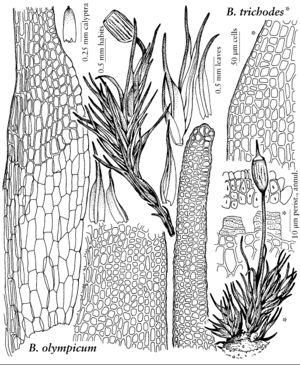Difference between revisions of "Brachydontium olympicum"
Bryologist 89: 200. 1986,.
Basionym: Grimmia olympica E. Britton Bryologist 13: 59, plate 7. 1910
Treatment appears in FNA Volume 27. Treatment on page 328.
FNA>Volume Importer |
imported>Volume Importer |
||
| Line 47: | Line 47: | ||
|publication year= | |publication year= | ||
|special status= | |special status= | ||
| − | |source xml=https:// | + | |source xml=https://bibilujan@bitbucket.org/aafc-mbb/fna-data-curation.git/src/bb6b7e3a7de7d3b7888a1ad48c7fd8f5c722d8d6/coarse_grained_fna_xml/V27/V27_455.xml |
|genus=Brachydontium | |genus=Brachydontium | ||
|species=Brachydontium olympicum | |species=Brachydontium olympicum | ||
Revision as of 22:32, 27 May 2020
Stems 2–5 mm. Leaves 1–2.5 mm, distal laminal cells mostly isodiametric, 1:1, with a few cells 2:1 or transversely elongate, areolation somewhat irregular, proximal cells longer. Seta 0.5–2 mm, flexuose when dry. Capsule spherical to short-ovate, 0.4–0.6 mm. Peristome absent. Spores 6–10 µm.
Habitat: Moist, acidic boulders, montane, predominantly alpine
Distribution
B.C., Alaska, Oreg., Wash., e Asia (Japan).
Discussion
The spherical or short-ovate capsules absent peristome teeth and the somewhat shorter distal laminal cells distinguish Brachydontium olympicum from B. trichodes. This is a circum-North Pacific montane species, which should be sought for in coastal areas of Siberia.
Selected References
None.
Lower Taxa
None.
